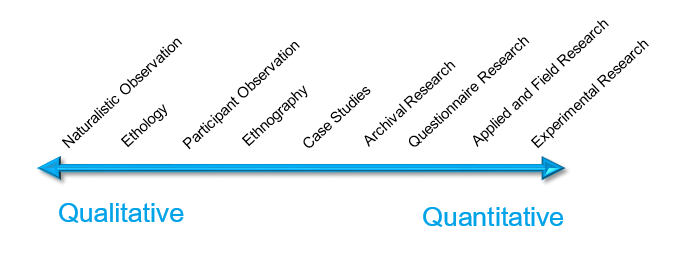
 In this section, you will find an overview of different research methods in psychology. You will find links to tools and resources in the library related to the different types of research and writing.
In this section, you will find an overview of different research methods in psychology. You will find links to tools and resources in the library related to the different types of research and writing.
If you have any questions about how to use the tools ands resources included here, please contact your librarian!
Research in Psychology is categorized into two general methods:
 Qualitative Research
Qualitative Research
Non-numerical evidence, usually examined in its raw form
Used when a researcher wants to understand people's opinions, idiosyncratic responses to an event, motivations, or underlying reasons for actions or decisions.
Learn about the Types of Qualitative Research Methods. link will open in a new window
Example: Interviewing the victims of a natural disaster to gather a range of emotional responses.
 Quantitative Research
Quantitative Research
Numbers! Collected as numerical data or converted into numerical data and examined using statistical methods of analysis.
Used to examine trends and compare populations.
Learn about the Types of Quantitative Research Methods. link will open in a new window
Example: Asking victims of a natural disaster to rank their feelings of anxiety using a pre-determined scale.
When to use them
Psychological research is best when it uses complementary quantitative and qualitative approaches together in the same study, a method called triangulation.
Example: Observing parent-child interactions while watching tv then comparing those observations to measured rates of social and cognitive development in the children who participated in the study.
The Research Continuum

Learn more about Qualitative and Quantitative methods and how to incorporate them into your writing with ebooks from the Library...
 Observational Studies
Observational Studies
The researchers record data by studying participants at a distance. Researchers try not to influence the participants or their actions.
Types of observational studies include: Naturalistic Observation link will open in a new window, Participant Observation link will open in a new window, or Ethnography. link will open in a new window
 Case Studies
Case Studies
The researcher will collect and write detailed accounts of individual lives. A case study can combine a few research approaches, including interviews, observational data, and archival data.
Examples of Case Studies include Freud's history of Anna O link will open in a new window., and the stories related in Oliver Sacks's best selling book The Man Who Mistook his Wife for a Hat link will open in anew window.
 Archival Research
Archival Research
A researcher applies their own analytical model to data that has already been collected. They attempt to answer a new question or discover a new trend by looking at old data.
Typical sources of archival data include: census datalink will open in a new window , court records will open in a new window , medical records, and even case files from other researchers.
 Questionnaires
Questionnaires
Participants are asked a standard set of questions. These questions may be delivered in writing or through an interview format.
There are three main types of questionnaire methods: Random Sampling link will open in a new window , Stratified Sampling link will open in a new window , and Convenience Sampling link will open in a new window .
 Applied and Field research
Applied and Field research
Researchers are trying to find a solution to an immediate, practical problem. Examples include reducing drug use or improving worker happiness.
Field research is a type of applied research that is undertaken in a non-laboratory setting. These settings may include a hospital or workplace.
 Experimental Research
Experimental Research
Research conducted in a controlled environment. The results help scholars in the field to learn more about psychological processes such as cognition or emotional development.
1. Read the Abstract
In a Summon results page, click Preview to read the Abstract. Look for information about the study's methodology.

2. Find the Methods section.
In the Article's Full Text, the Methods are usually outlined in the second or third section under a heading that reads "Method" or "Methodology."
Is the method describe Qualitative or Quantitative?
How many people participated? How were participants selected?
What method did the researchers use?

 Need a little extra help?
Need a little extra help?
Or use the links below to find more in-depth information and help on Methods for Psychological Research.